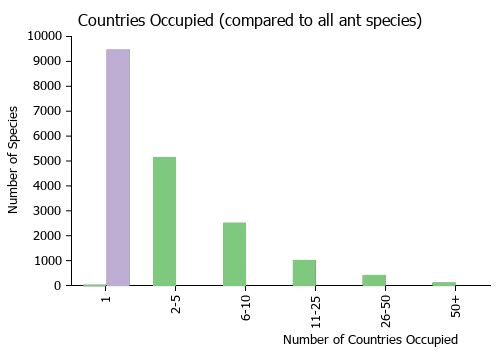Nebothriomyrmex majeri
| Nebothriomyrmex majeri | |
|---|---|

| |
| Scientific classification | |
| Kingdom: | Animalia |
| Phylum: | Arthropoda |
| Class: | Insecta |
| Order: | Hymenoptera |
| Family: | Formicidae |
| Subfamily: | Dolichoderinae |
| Tribe: | Leptomyrmecini |
| Genus: | Nebothriomyrmex |
| Species: | N. majeri |
| Binomial name | |
| Nebothriomyrmex majeri Dubovikoff, 2004 | |
The only species in the genus, the types (workers only) were collected in a pitfall trap. Although it is not uncommon in the Darling Range, Nebothriomyrmex majeri is particularly abundant in coastal peppermint (Agonis flexuosa) scrubland around Bremer Bay. Here, many clusters of ant colonies can be found in white sand under rotted wood and around tree and shrub roots. Given their close association with roots in these circumstances, they may be tending root aphids or other Hemiptera. (Heterick 2009)
Identification
Worker. Palpal index 6:4. Eyes small (with about 20 facets), situated near antennal sockets; simple ocelli absent. Antennae 12-segmented. Mandibules with 4 or 5 small teeth. Median hypostoma developed, without emargination. Metanotal depression deep. Main surface of propodeum situated distinctly below mesonotum. (Dubovikoff, 2004)
Keys including this Species
Distribution
Southwestern Australia.
Latitudinal Distribution Pattern
Latitudinal Range: -32.11666° to -34.96667°.
| North Temperate |
North Subtropical |
Tropical | South Subtropical |
South Temperate |
- Source: AntMaps
Distribution based on Regional Taxon Lists
Australasian Region: Australia (type locality).
Distribution based on AntMaps
Distribution based on AntWeb specimens
Check data from AntWeb
Countries Occupied
| Number of countries occupied by this species based on AntWiki Regional Taxon Lists. In general, fewer countries occupied indicates a narrower range, while more countries indicates a more widespread species. |

|
Estimated Abundance
| Relative abundance based on number of AntMaps records per species (this species within the purple bar). Fewer records (to the left) indicates a less abundant/encountered species while more records (to the right) indicates more abundant/encountered species. |

|
Biology
Castes
Only known from workers.
Worker
Images from AntWeb

| |
| Worker. Specimen code casent0009951. Photographer April Nobile, uploaded by California Academy of Sciences. | Owned by CAS, San Francisco, CA, USA. |
    
| |
| Worker. Specimen code casent0106174. Photographer April Nobile, uploaded by California Academy of Sciences. | Owned by ANIC, Canberra, Australia. |
Nomenclature
The following information is derived from Barry Bolton's Online Catalogue of the Ants of the World.
- majeri. Nebothriomyrmex majeri Dubovikoff, 2004a: 523 (w.) AUSTRALIA.
Unless otherwise noted the text for the remainder of this section is reported from the publication that includes the original description.
Description
Worker
Body yellow, abdomen slightly darker. Erect hairs present on the clypeus (2 chaetae directed forwards in middle part and 2, directed downwards at anterior margin) and abdomen (tergites II and III with sparse chaetae, tergite IV with about 7 chaetae). Recumbent pubescence of body delicate, consisting of dense fine short hairs. Eyes situated in lower part of head. Scape short, far not reaching occipital margin of head. Clypeus slightly depressed in middle. Main surface of propodeum convex; sloping surface flat, not concave. Sacle fine, smoothly rounded upwards.
Length of body: 1.5-1.9 mm. CI = 85-89 (89), SI = 65-68 (65).
Type Material
- Holotype, worker, Redross goldmine, 60km S Kambalda, Western Australia, Australia, Curtin Univ. (Perth).
- Paratype, 3 workers, Alcoa burn project (?Jarrahdale district), Western Australia, Australia, Curtin Univ. (Perth).
- Paratype, 1 worker, Dwellingup, Western Australia, Australia, Curtin Univ. (Perth).
- Paratype, 6 workers, Peppermint Grove, Western Australia, Australia, Curtin Univ. (Perth).
- Paratype, 1 worker, Reabold H., Western Australia, Australia, Curtin Univ. (Perth).
- Paratype, 2 workers, Torndirrup National Park, Western Australia, Australia, Curtin Univ. (Perth).
- Paratype, 2 workers, Redross goldmine, 60km S Kambalda, Western Australia, Australia, ZISP (St. Petersburg).
Etymology
The species is named for Prof. J. Majer, curator of the collection of ants in CUTP.
References
- Dubovikoff, D.A. 2004b. Nebothriomyrmex majeri gen. et sp. n., a new genus and species of ants (Hymenoptera, Formicidae, Dolichoderinae) from Australia. Entomologicheskoe Obozrenie 83(2): 487-489, 511 (page 488, worker described)
- Dubovikoff, D.A. 2005. The system of taxon Bothriomyrmex Emery, 1869 sensu lato (Hymenoptera: Formicidae) and relatives genera. Kavkazskii Entomologicheskii Byulleten 1(1): 89-94 (page 91, Referred to new tribe Iridomyrmecini)
- Heterick, B. E. 2009a. A guide to the ants of South-western Australia. Records of the Western Australian Museum, Supplement 76: 1-206. Part 1.
- Heterick, B.E. 2021. A guide to the ants of Western Australia. Part I: Systematics. Records of the Western Australian Museum, Supplement 86, 1-245 (doi:10.18195/issn.0313-122x.86.2021.001-245).
- Heterick, B.E. 2022. A guide to the ants of Western Australia. Part II: Distribution and biology. Records of the Western Australian Museum, supplement 86: 247-510 (doi:10.18195/issn.0313-122x.86.2022.247-510).
References based on Global Ant Biodiversity Informatics
- Heterick B. E. 2009. A guide to the ants of south-western Australia. Records of the Western Australian Museum Supplement 76: 1-206.

